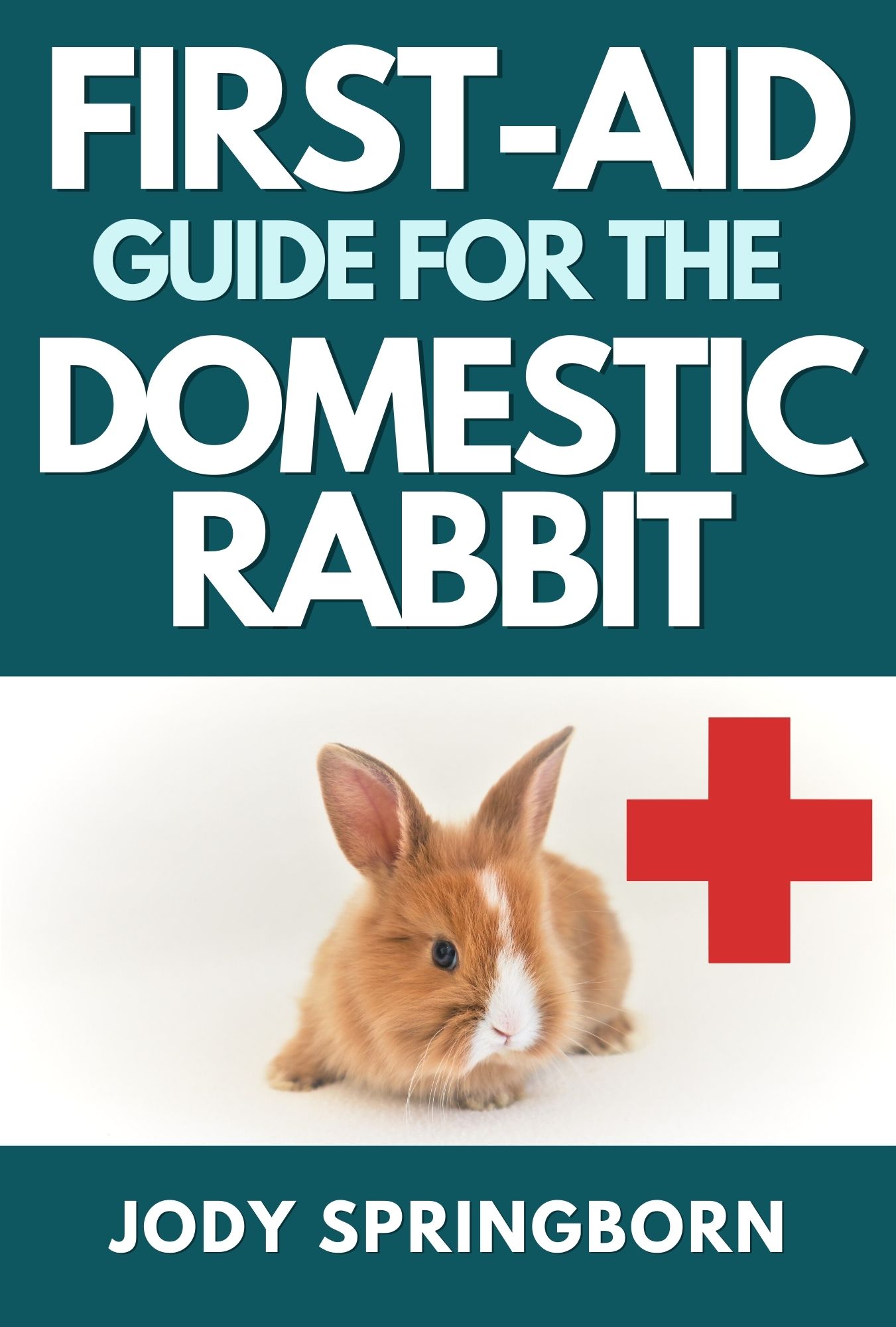- Home
- Rabbit Diet
- Hay for Rabbits
Types of Hay for Rabbits
It's All About the Hay
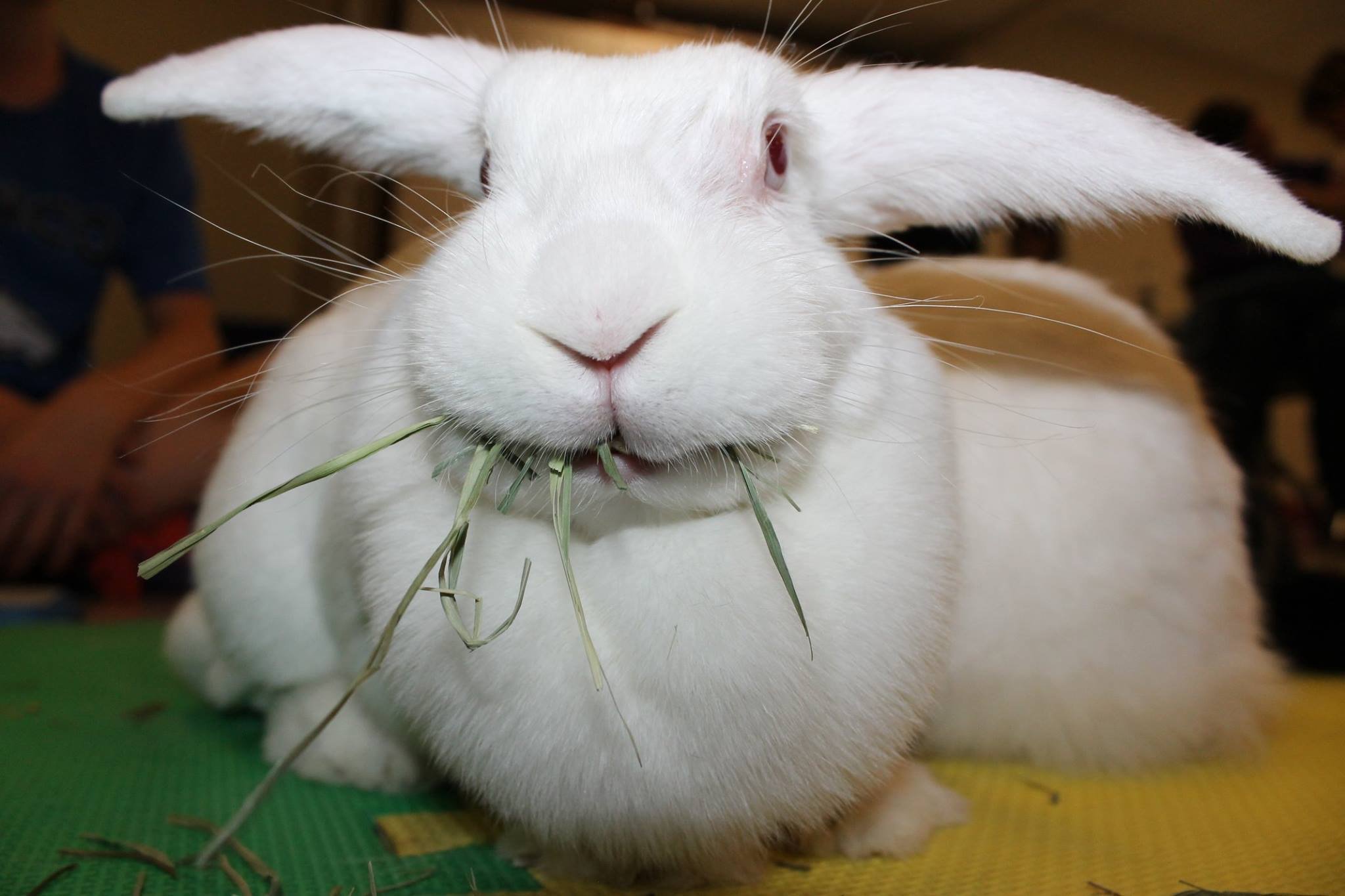 Sarah eating hay.
Photo courtesy of Against All Odds Rabbit Rescue (Calgary, Canada)
Sarah eating hay.
Photo courtesy of Against All Odds Rabbit Rescue (Calgary, Canada)Think Hay for Rabbits Isn't Necessary? Think Again.
The majority of a rabbit’s diet should be a grass hay (at least 75-80%). There are many different types of hay for rabbits that are appropriate. It can be an oat or oat blend, timothy, orchard grass, Bermuda grass, meadow fescue grass, brome grass, rye, barley or wheat grass or mix of all. I will focus on the main types of hay: oat, Timothy and orchard, as they are widely available in pet and feed stores. A variety makes things more interesting for a rabbit and broadens the nutrients being consumed, so don't be afraid to mix two or more types together. It should be noted that the nutrient content can vary greatly, as it depends on the age of the plant, when it’s harvested and how it is dried and stored. Babies, pregnant and/or nursing females should have alfalfa hay.
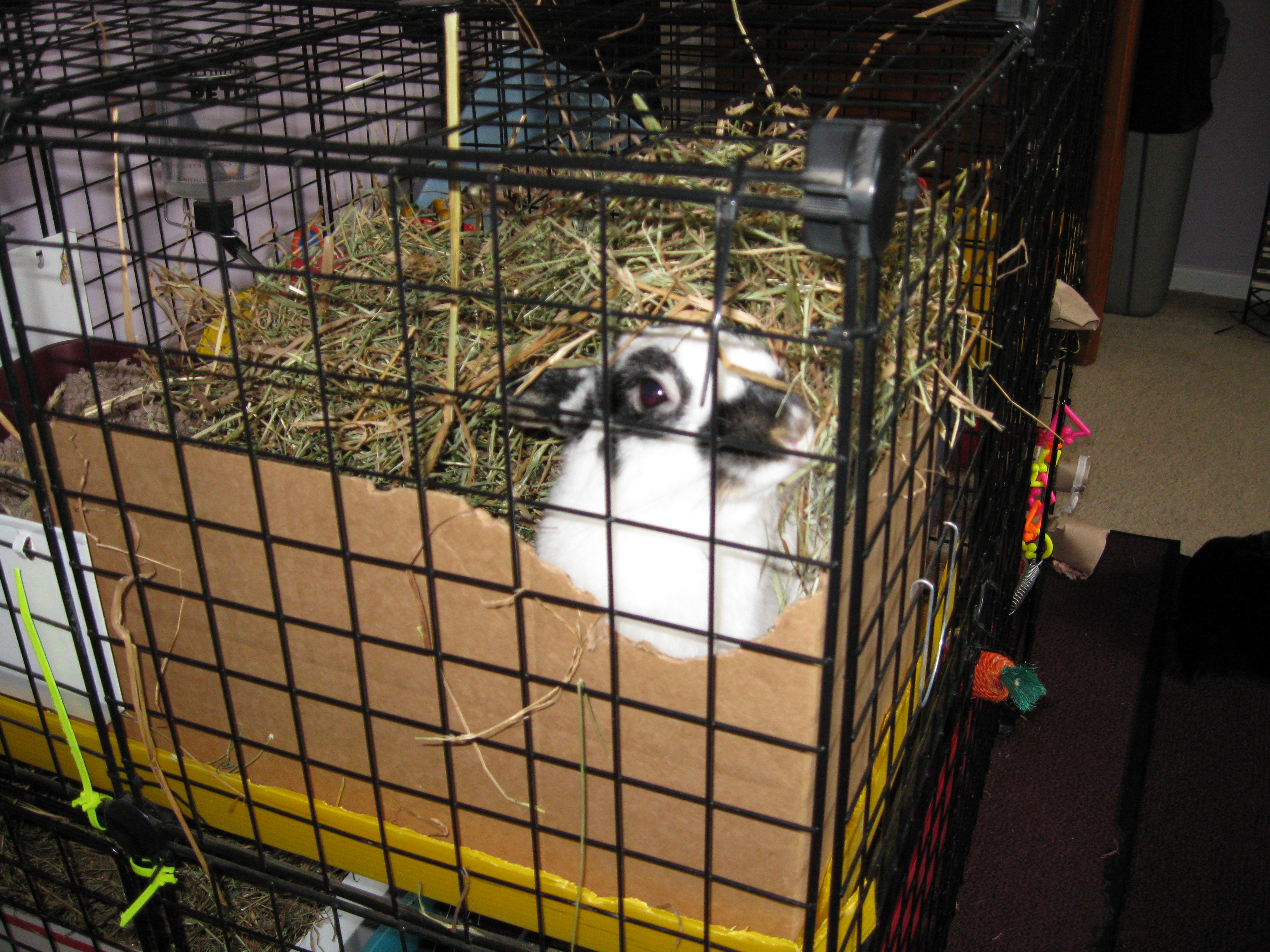 At the time of this photo, Oso loved to dig in the hay, so he had both a litter box AND a hay box in which to play/eat.
At the time of this photo, Oso loved to dig in the hay, so he had both a litter box AND a hay box in which to play/eat.Fiber is so important to keep the gut moving. The bunny should have unlimited access to hay. I recommend that the hay should be available in the litter box, as rabbits are grazing animals. By having the hay in the litter box, this compliments their natural inclination to eat and poop at the same time and accommodates their natural foraging behavior. Since rabbits will not eat soiled hay, it is important to always have clean hay present. This means giving your rabbit about a shoebox full of fresh hay twice daily. Please note, hay racks or hay balls should not be the only source of hay, because they do not hold enough. You can have them present either as a toy or just as an extra place for your bunny to grab a snack.
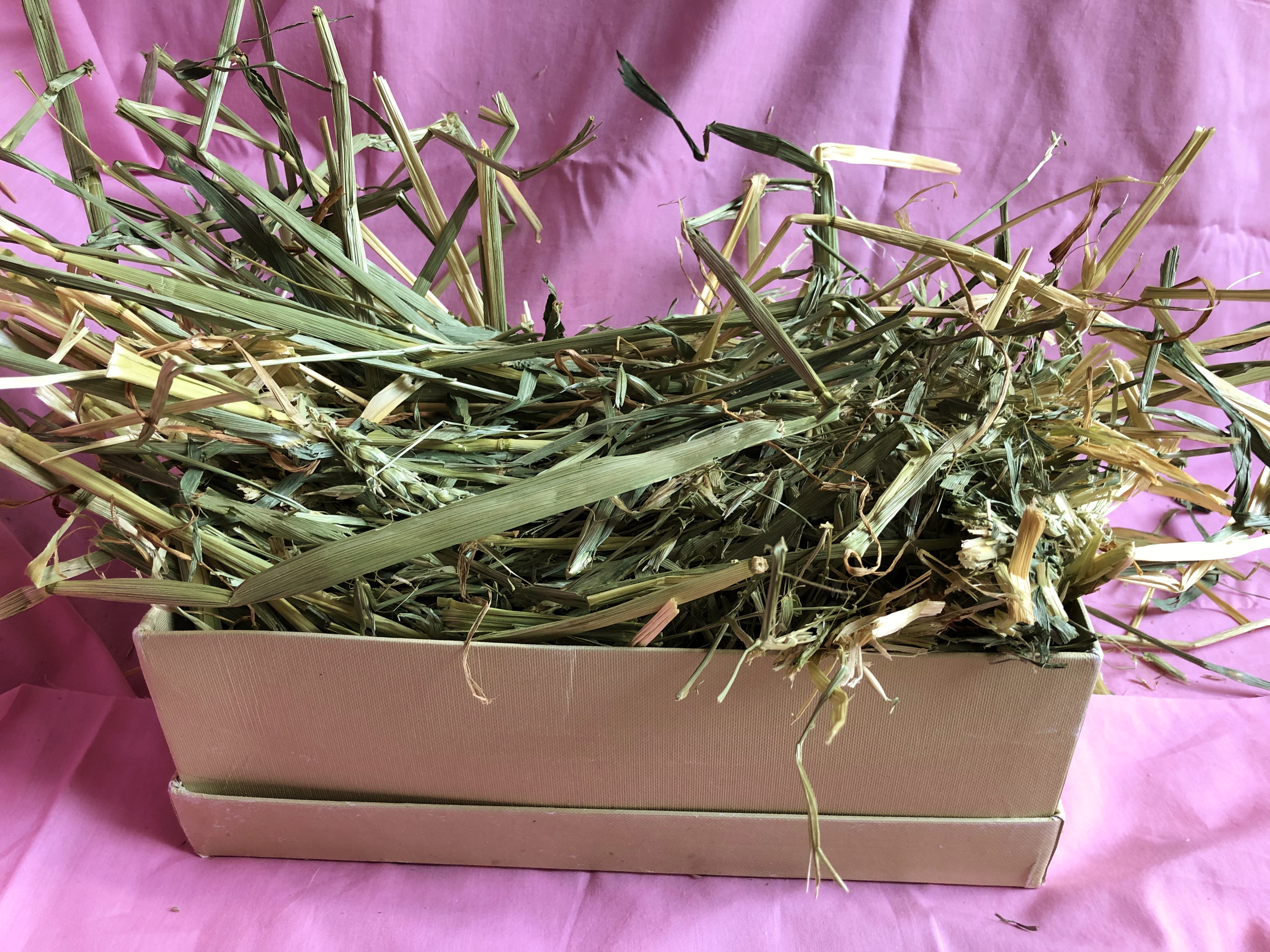 Daily Serving Size of Hay
Daily Serving Size of HaySince there are so many different types of hay for rabbits, is one kind better than another? In terms of nutrients, hay has low nutritional value. Many of the vitamins the plants produce during the growing season can be lost during harvest and storage. The value in hay comes with the fiber (which is essential to keeping the gut moving) and the silicates (which help wear down the teeth). The main nutrients taken from the hay are fiber, fat, calcium and protein.
Oat (or Oat Blend) Hay
Oat (sometimes can be found mixed with other grass hays such as wheat, rye or barley) is high in fiber and fat. The color can vary from green to yellow and often has some seed heads attached, which are a big hit with the bunnies.
It’s good for bunnies needing to gain a little extra weight. Does this mean oat should not be fed out if your bunny is overweight or doesn't have a weight problem? That can depend on the individual bunny. Based on my experience, a fat bunny is usually the result of too many pellets and/or treats. Some breeds, like the Rex, are going to be more prone to weight problems. As an owner, you need to be more mindful of how many treats you give out and how much exercise your Rex bunny gets.
Generally speaking, if your bunny prefers oat and eats most of what is offered, then I wouldn't worry about it. However, if your bunny selectively eats the seed heads (and rarely eats the stems or leaves) or has a problem with soft stools, then I would think about switching to Timothy, or at least, offering half Timothy and half oat.
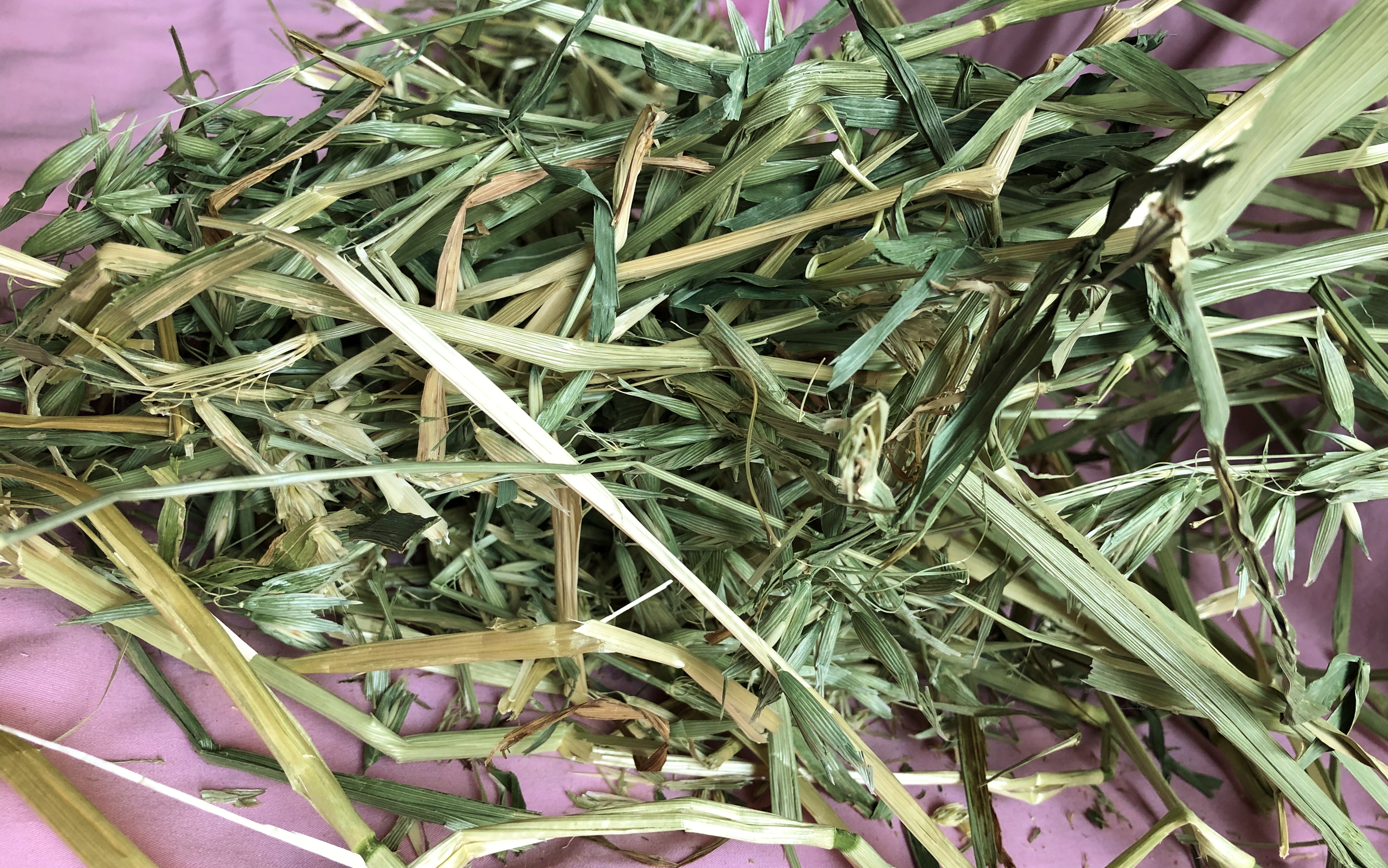 Oat Blend Hay (pictured - oat, wheat and barley). Color can vary from mostly green to mostly yellow. It's usually the preferred hay for most rabbits.
Oat Blend Hay (pictured - oat, wheat and barley). Color can vary from mostly green to mostly yellow. It's usually the preferred hay for most rabbits.Timothy Hay (1st, 2nd & 3rd cut)
Timothy hay is the most common type of hay for rabbits found in pet stores and it's often given to other small animals, such as guinea pigs and chinchillas. It can come in 1st, 2nd and 3rd cutting, which refers to harvests done within the same growing year. The 1st cutting is the first harvest of the season, usually in late spring. It has a lot of stems and seed heads, and it is the coarsest of all the cuts. It is high in fiber. The 2nd cut is done about late summer and is a balance blend of leaves and stems. There is a lower level of fiber, but a higher level of fats and proteins. The 3rd cut may happen in the Fall, weather permitting. It is primarily leaves, making it a much softer hay. Out of all of the three cuts, the 3rd has the highest level of fats and proteins, but lowest in fiber. Still, it is an acceptable type of hay to feed your bunnies daily if they enjoy it.
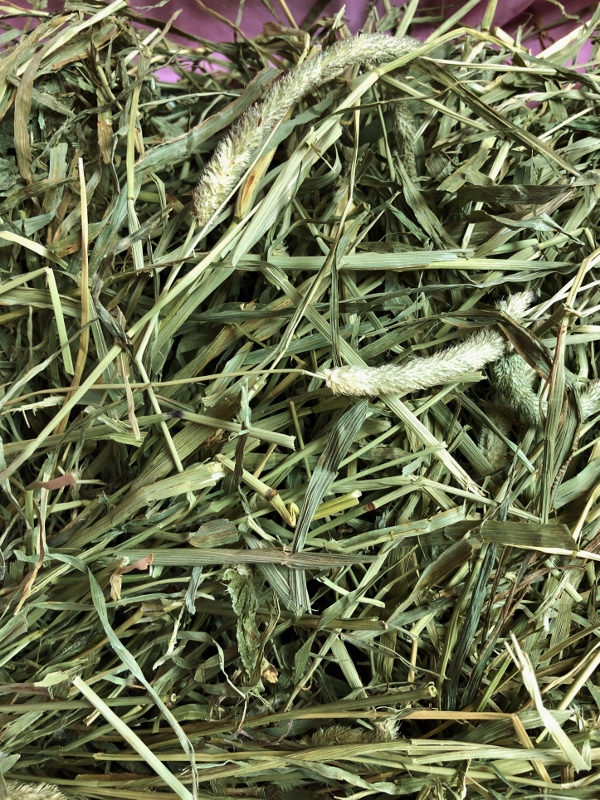 Timothy 1st cut - mostly stems, high fiber. Timothy 1st cut - mostly stems, high fiber. |
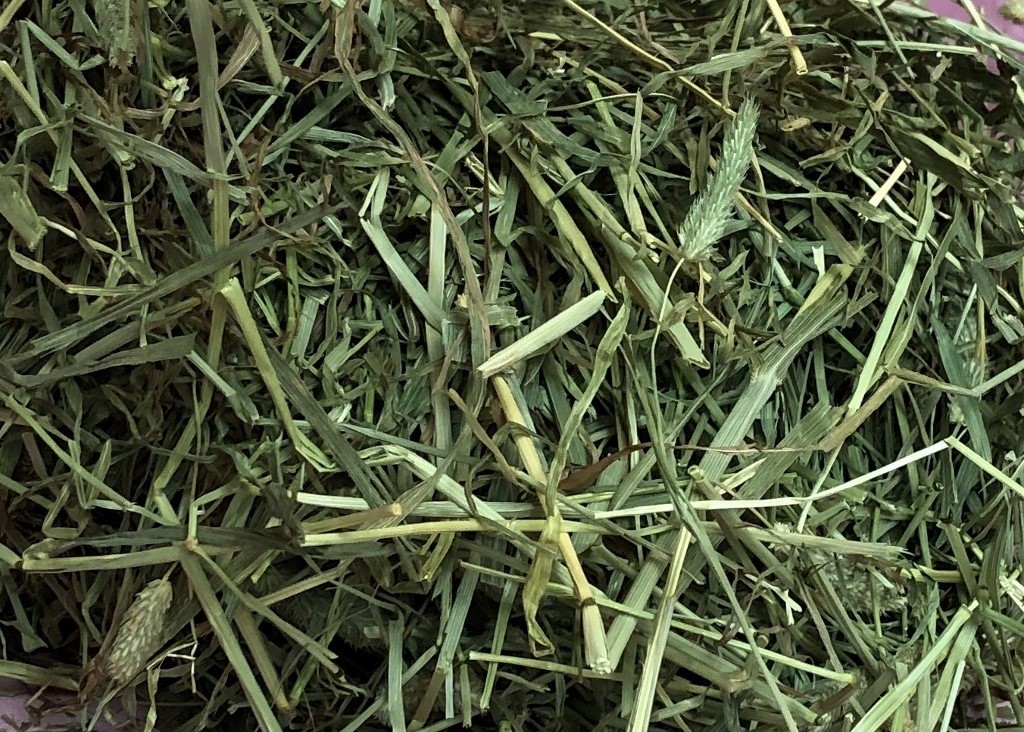 Timothy 2nd cut - an equal portion of stems and leaves Timothy 2nd cut - an equal portion of stems and leaves |
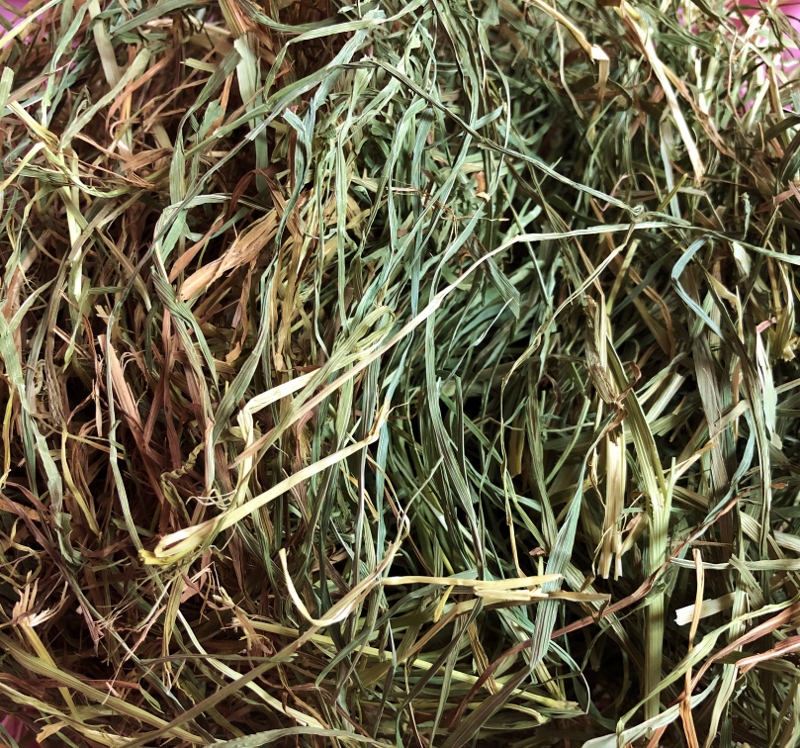 Timothy 3rd cut - softest of the three cuts and lowest in fiber.
Timothy 3rd cut - softest of the three cuts and lowest in fiber.Orchard Grass
This is a soft hay, which is high in fiber and low in protein. This hay is less dusty than either the oat or Timothy hays, which gives human allergy sufferers some relief. It is also a good choice for those rabbits who have dental issues or missing teeth.
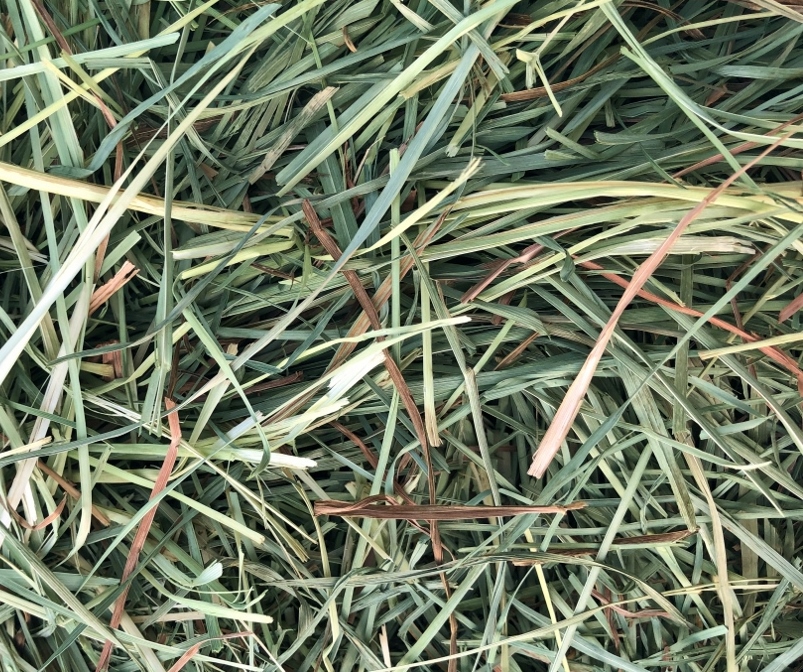 Orchard Grass
Orchard GrassAlfalfa Hay
Alfalfa hay is not a grass hay, but rather a legume (in the pea family). Unlike grass hays, it is packed with vitamins, minerals, calcium, proteins and fiber. Other plants such as clover and soybeans are also examples of legumes. Sometimes clover heads may be found in another grass hay or as a dried treat. Soybeans are often found in pellets.
This kind of hay I would not feed out to a healthy, normal adult rabbit. Alfalfa is a good choice for baby bunnies up to 8 months of age and pregnant or lactating mothers. It can also be fed out to malnourished or elderly bunnies who need the extra nutrients. However bunnies fed exclusively on alfalfa hay long-term can experience bladder sludge and other digestive issues. Sometimes senior bunnies need a little extra nutrition to keep their weight up. Alfalfa can be a good choice, but it would be better to mix a small amount of alfalfa with a grass hay, rather than feeding straight alfalfa.
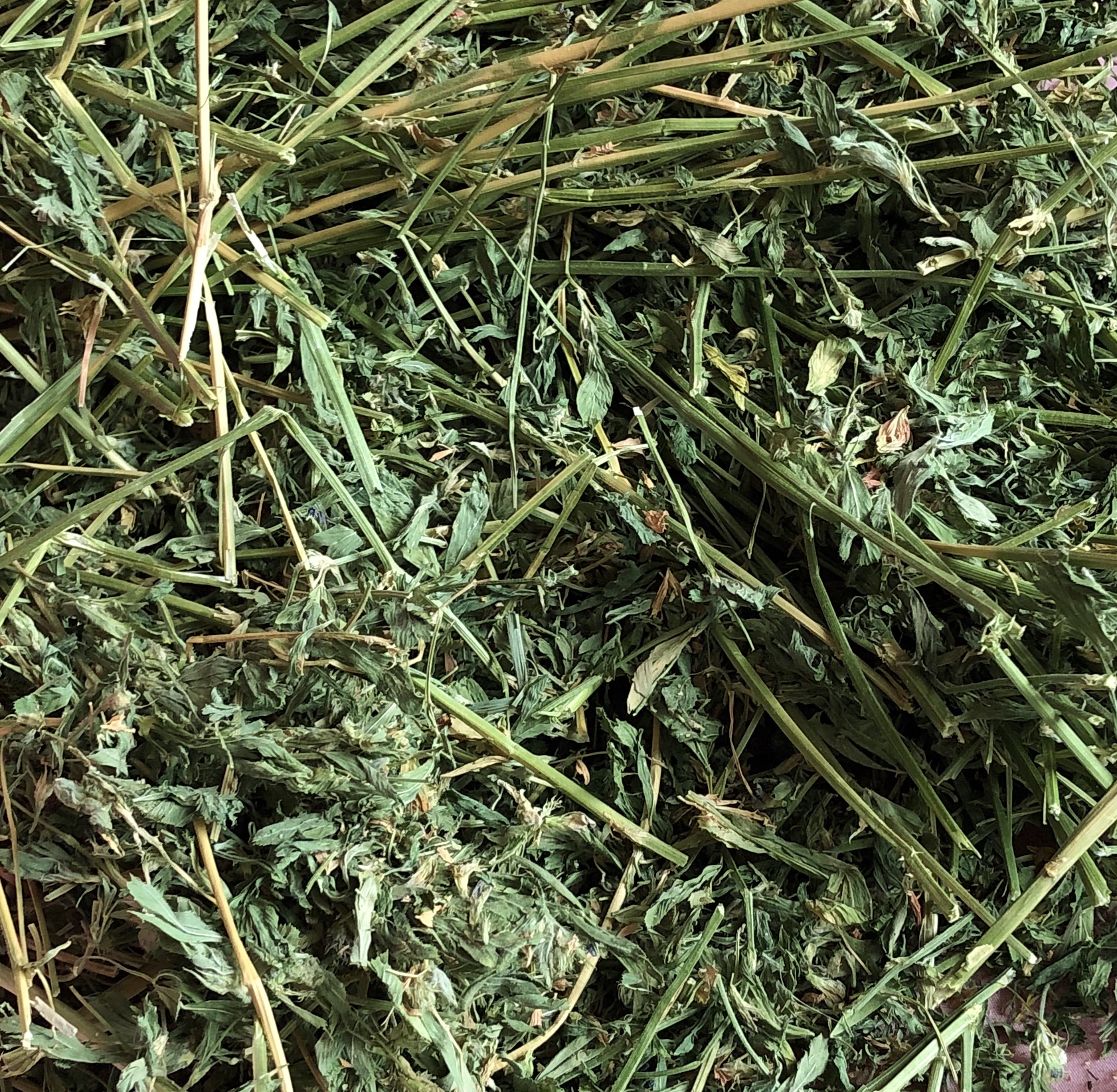 Alfalfa hay - the bunnies like to eat the leaves and flowers first before the stems.
Alfalfa hay - the bunnies like to eat the leaves and flowers first before the stems.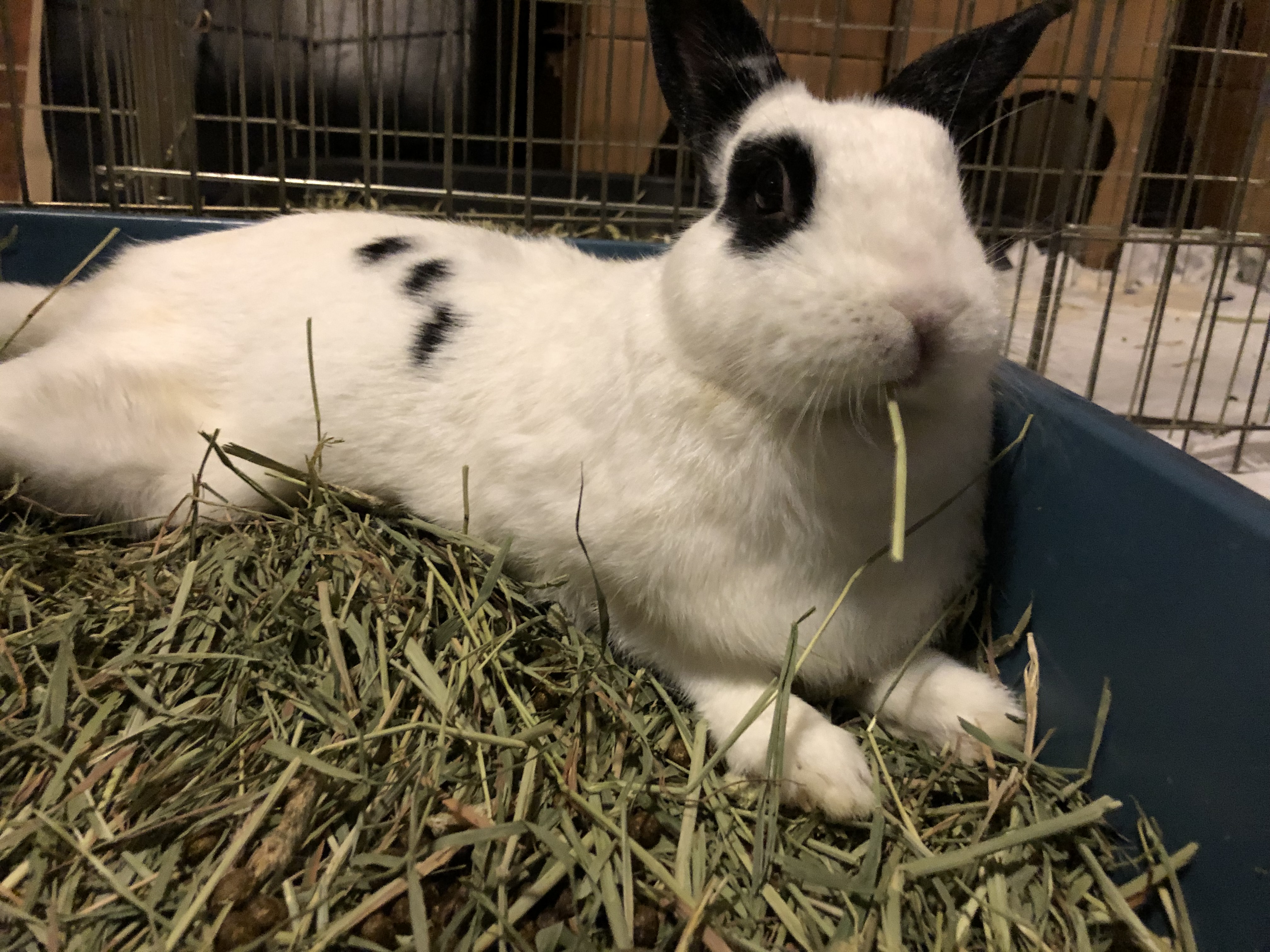 Zoe always enjoys a nice snack in bed.
Zoe always enjoys a nice snack in bed.Hay can be readily purchased at local pet stores in small bags. There is some disadvantages to this convenience. It tends to be expensive, especially if you have multiple rabbits. New bunny owners are surprised to learn that a 1lb bag is good for maybe 2 days. That kind of expense can add up very quickly. Another problem I have seen is the quality. Even though it may be fine in terms of the guaranteed nutritional analysis, it doesn’t taste very good. Quite often I have seen rabbits who are not fond of store-bought hay, eat fresh hay much more enthusiastically. Usually store bought hay has been sitting around in storage and warehouses for some time and can lose some of the palatability. I compare it to stale bread. Everyone loves fresh out of the oven bread. Pretty much no one enjoys stale bread.
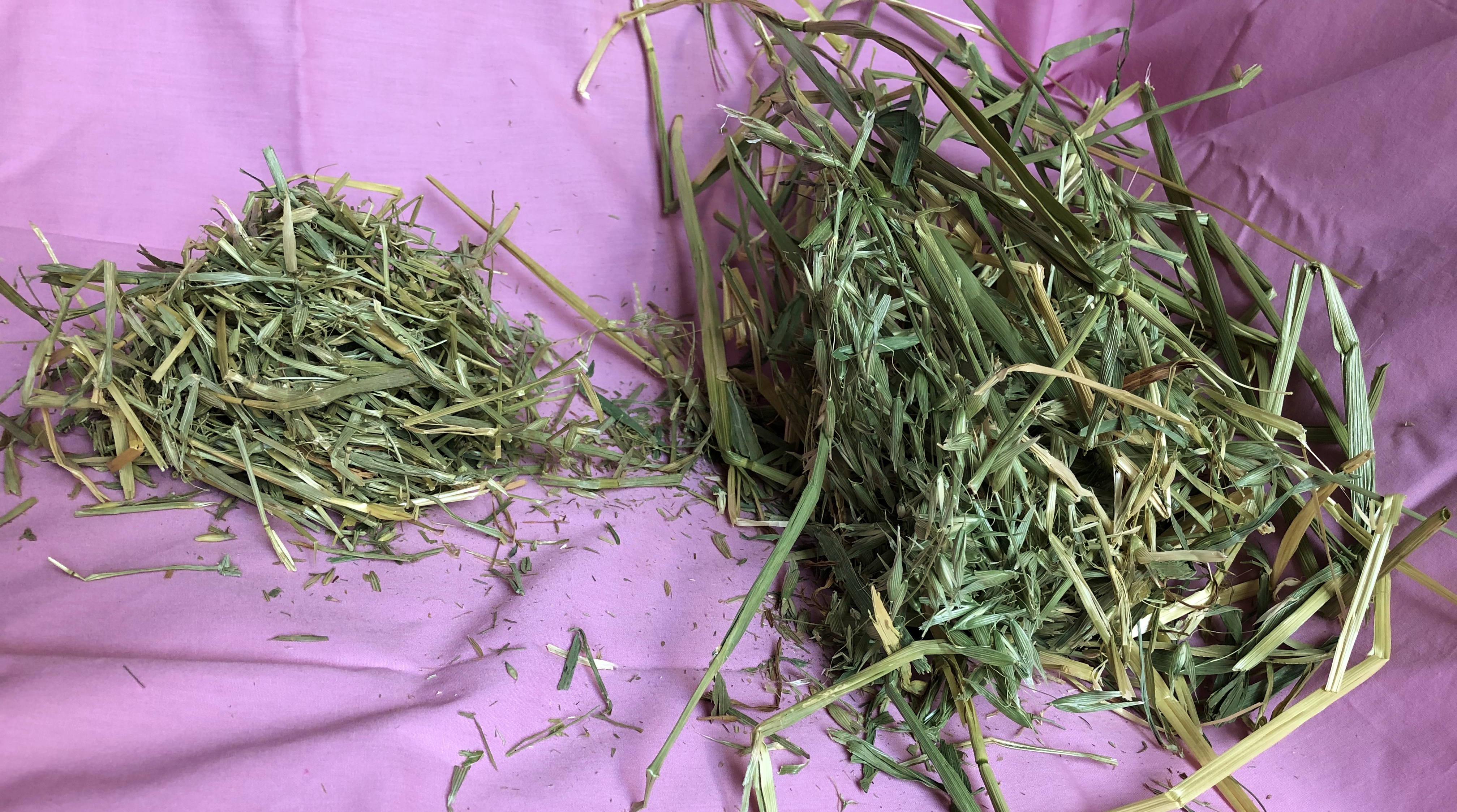 The oat hay on the left was purchased in a pet store. The hay is shorter and the color tends to be more uniform. The oat blend on the right was purchased from a feed store. The stems are longer and there is more variation in the color.
The oat hay on the left was purchased in a pet store. The hay is shorter and the color tends to be more uniform. The oat blend on the right was purchased from a feed store. The stems are longer and there is more variation in the color.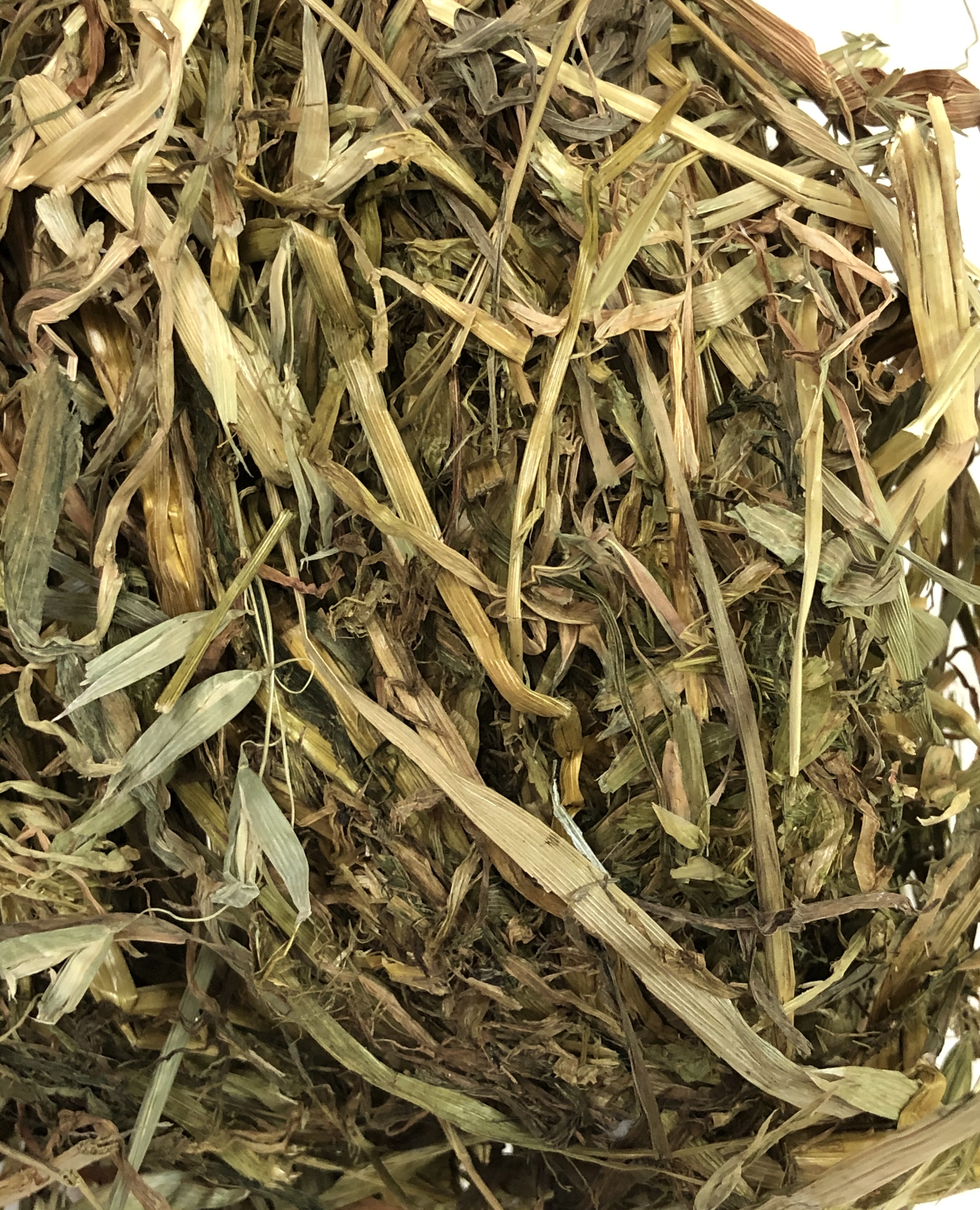 Moldy oat hay. Do not feed this to your bunnies.
Moldy oat hay. Do not feed this to your bunnies.A better alternative is to purchase hay from either a feed store that caters to horse owners or a local farmer. There are even some farmers who will sell hay online and ship it to you, although the price of shipping tends to be more expensive than the hay. The hay will be more tasty to your rabbit and be more cost effective. The disadvantage is the size. It’s harder to store a bale of hay rather than a small bag. Some feed stores will sell a flake or two (a flake is about 5lbs, depending on how it is baled). The quality may not be uniform either. How a bale looks on the outside may not be the same on the inside. Be sure to inspect the hay as you feed it out. The one thing you want to watch out for is mold. Blackish discoloration, grey dust or hay that looks like the bunny has urinated on it will all be signs that it should not be used. Do not let your bunny eat moldy hay. The risk of mycotoxins can be significant. Mycotoxins are produced by certain molds and can be deadly to your rabbit.
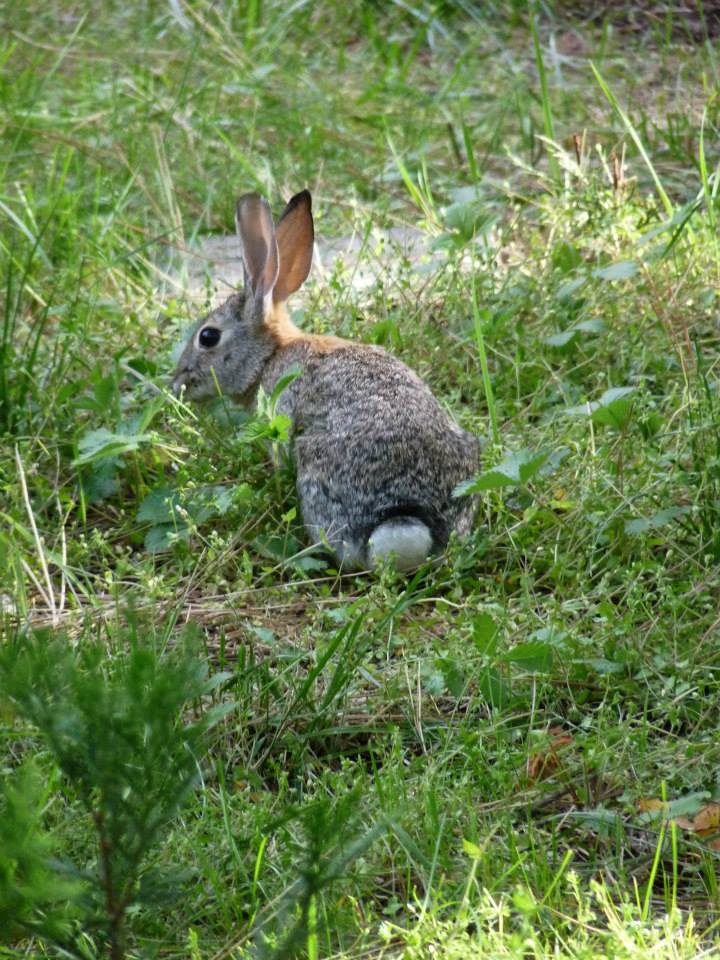 Wild rabbit foraging.
Wild rabbit foraging.Can a rabbit graze on your lawn? Rabbits are fond of fresh grass, but as mentioned in the previous section under housing, you want to be aware of predators getting into a pen or bunnies escaping, even if the visit outside is only for a short time. Grass should not be recently fertilized or treated with herbicides or pesticides. Make sure any weeds growing in the lawn are suitable for rabbit consumption. Rabbits are at greater risk of being exposed to potential bacteria, fungi and parasites, such as fleas, ticks and flies. Of course if you live in an area where RHDV is present, you must get your rabbit vaccinated.
A safer alternative to letting your bunny romp in the backyard would be to grow your own fresh grass. Wheat, barley, buckwheat and oat grass are relatively easy to grow, and make a nice snack for bunnies.













